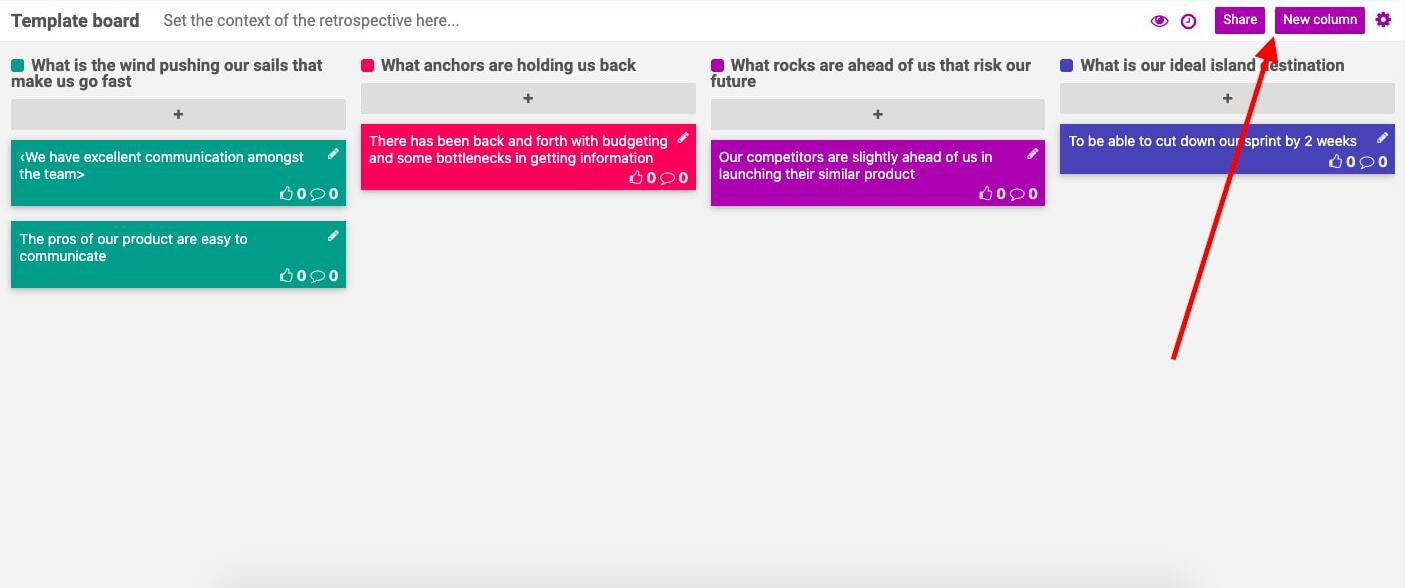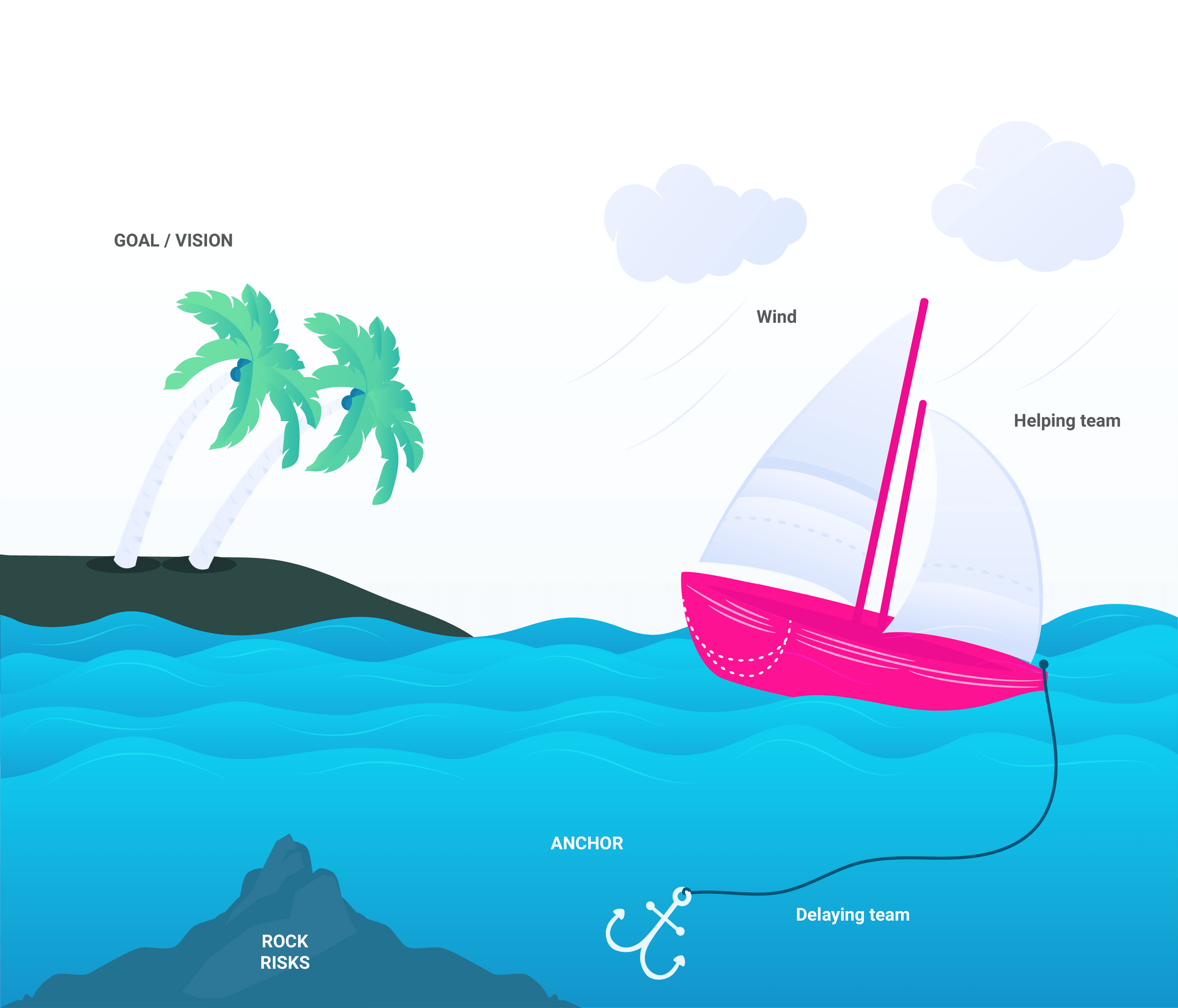Sailboat Retrospective
You know the term ‘smooth sailing’? Imagine you could apply it to all of your current projects and future sprints. Using the Sailboat Retrospective technique can help you achieve team cohesiveness using a fun, visual exercise that gets all of your team members on the same page — or should we say— boat.

What exactly is a Sailboat Retrospective?
The Sailboat technique for retrospectives is a fun, interactive, and low-key way for your team to reflect on a project. It helps team members to identify what went right, what went wrong, and what improvements and changes can be made in the future. Usually the retrospective happens immediately after the completion of a project or sprint.
This technique uses the metaphor of a sailboat heading toward shore to help teams visualize their ship (team) reaching its ultimate destination (or ultimate goals).
Let’s look at a quick breakdown of the pieces involved:
Anatomy of the Sailboat Retrospective
In a Sailboat exercise, there are traditionally five main components:
- The sailboat: The team itself (or some teams prefer to make this the project)
- The island or shore: The ultimate goal or vision for the team (where it’s headed)
- The wind (or the sails): Things that are helping the team glide along (team strengths, competitive advantages of your product, good communication, etc.)
- The anchors: things that are slowing the team or project down or delaying progress (silos, areas of weakness, etc.)
- The rocks: the risks or potential pitfalls of a project (areas of tension, bottlenecks, competition, etc.)
Some Sailboat Retrospectives incorporate other aspects that fit into their vision such as the sun, which represents things that make the team feel happy or satisfied; or, choppy waves to represent something the team feels anxious about.
Some teams even scale their sails for bigger vs. smaller problems. If you have quite a few people involved in your retrospective or you have a lot of issues and need a way to prioritize, this is an option.
Feel free to get creative and add any aspects you feel would be beneficial to your retrospective. (This can be easily done via our Sailboat Retrospective template by adding additional columns. See below.)

Why is the Sailboat Retrospective technique so effective?
The effectiveness of the Sailboat Exercise lies in its ability to use relatable metaphors to help team members easily identify important strengths and weaknesses. Because it is more of a non-pressure approach, it can help team members feel relaxed and more open to communicate without overthinking things.
This exercise is a fun way to get your team out of their day-to-day and think about the ‘big-picture’ to continually improve processes. It can also be a nice way of mixing up your retrospectives to keep them fresh and engaging.
And just because it’s fun doesn’t mean it’s not effective! The average Sailboat Retrospective normally helps to identify around 3-5 action items. That’s 3-5 new ways that your team can enhance their performance!

How to run one with your team
Ready to try your own Sailboat method retrospective?
Note: This exercise should take around 60 to 90 minutes to complete.
1. First, gather your key stakeholders
Usually, a retrospective includes the Scrum Master, Product Owner and members of the Scrum team. If there are other key stakeholders for your specific project invite them to the retrospective as well. This specific type of exercise really benefits from having different opinions and perspectives.
If your team is distributed or remote (as many are these days) you can still perform the Sailboat Exercise. Consider using a great online tool designed specifically to help distributed teams facilitate retrospectives.
2. Set some ground rules
It’s important to set the tone for how you envision your retrospective going. There are a few things that should never be included in any retrospective, and the Sailboat method is no exception. Keep your retrospective free of:
- Blame
- Judgement
- Doubt
- Negativity
And make sure the focus is on:
- Having a growth mindset
- Being optimistic
- Being open-minded and open to constructive criticisms
- Being a psychologically-safe environment
3. Sketch your Visual
The rough sketch below is a pretty standard depiction for this type of retrospective. If you don’t want to draw your own, a simple Google search of sample Sailboat Retrospective images can help you find more examples.
Your visual should include all of the elements you’ll be discussing in order to help facilitate the exercise.

4. Set up your Template
Next, you’ll want to set up the template you’ll be using to capture your team’s thoughts. You can use a white board and post-its for this, but we’d suggest using an easy-to-build online template (like this one) to keep things organized.
Add all of the categories you will be discussing to your template. Then, take a few minutes to explain in detail what each category represents.
5. Brainstorming and/or discussion
Once your categories are all laid out on your template, you can either ask your team to quietly brainstorm for each one, or you can hold a group discussion. Really, this depends on the communication style of your team.
If you feel it might be better to have team members submit their feedback anonymously, they can write out their notations on post-its and you can gather them before discussion. Once you have everyone’s thoughts and additions, add them to your template.
6. Review
This is the final phase of the retrospective. At this point, you and your team should identify what the biggest successes of your project were and what attributes you’d like to carry forward.
Discuss your anchors (obstacles) and brainstorm ways to overcome them. Also discuss ways to mitigate your potential risks (rocks) and how close or far you are from reaching your ultimate goals.
Once everyone is on the same page, conclude your retrospective and move forward with a plan and improved understanding of team performance!
That’s all there is to it! We hope your team enjoys this retrospective and gains some valuable insights along the way.
Happy sailing!
